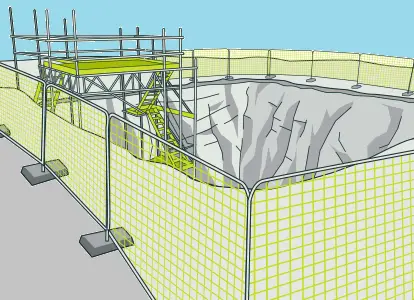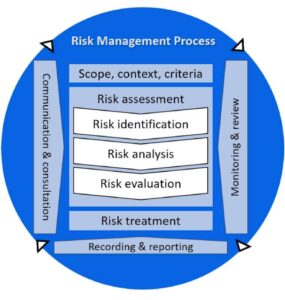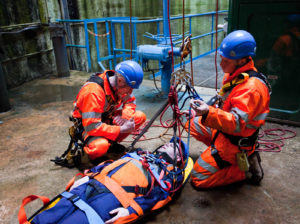Excavation safety guide with photos

Excavation safety with photos is a complete guide with respect to health and safety purposes. It is specially designed for professionals having responsibilities in the areas with buried services.
Key points Excavation safety guide with photos
Workers must avoid hitting underground utilities and services and must make sure that the nearby building and structures are safe due to their excavation workers must ensure safe excavation practice and excavate away from them
• Check & inspect the excavation every day prior to starting work activity and after an accident or adverse weather that might affect excavation stability.
• Provide safe access & egress facility to get in & out.
• Prevent collapse of excavation – by shoring, benching, or battering back. Do not assume that the sides ground will stand unsupported.
• Prevent workers, public & materials falling into excavation – with hard barriers rigid enough not to collapse if someone falls upon or against them.
Introduction
Excavation collapses & failures are generally hazardous & dangerous because they may occur very quickly, limiting the ability of employees or workers (and sometimes others nearby) to escape, especially if the collapse is big or extensive.
The speed of the collapse of excavation increases the risk which is associated with this type of work. The results are significant as the falling soil can crush or bury any human being in its way resulting in death or the person by suffocation & internal crush injuries.
What is excavation work? Excavation safety guide with photos
Excavation work means any work involving the removal of rock or soil from a worksite to make an open face, cavity or hole, using machinery, explosive or tools.
Excavation work can occur everywhere, including:
• on construction worksites
• on or inside business premises
• in public areas.
Excavation work includes:
• trial holes or potholing
• open excavations
• trial pit excavations
• trenches & retaining walls
• shafts & drives
OPEN EXCAVATIONS Excavation safety guide with photos
An excavation in an open earth ground is an open excavation & can vary in size & Shape.

POTHOLING
Potholing is generally a small inspection or excavation hole to find out underground services.

PIT EXCAVATIONS
Pit excavations are generally of four-sided & deeper than the narrow horizontal dimension at the surface.
Pits are usually excavated to install pump stations, manholes or underground tanks. Pits are also excavated to locate existing services construct pile caps & other types of foundations.
Pit excavations are usually 4-sided & deeper than the narrow horizontal dimension at the surface.

TRENCHES & RETAINING WALLS
A trench is a long narrow excavation in ground which is deeper than its width, and open to the surface along its length.
Trenches are usually excavated to maintain or install underground utilities & services or to investigate what is beneath the soil surface.

Trench
When a retaining wall is constructed, an open excavation becomes a trench formed by excavated face on one dimension and a retaining wall on the other. Usually, employees need to access this trench to work inside, for example for waterproofing the retaining wall.

A trench is made by putting up a retaining wall
SHAFTS & DRIVES
Drives are usually small openings cut into the sides of shafts or excavations or elsewhere, for example, under the roads or highways. Cutting a drive is particularly very hazardous as it introduces the risk of trapping excavating workers with no other alternative escape route.
Shafts & drives are often built to provide ventilation or access to a tunnel. Shallow shafts can be sunk for constructing or investigating the foundations, providing openings to facilities made underground or dewatering,

A person conducting a business or undertaking
This is the employer’s primary duty of care to ensure, so far as is reasonably practicable, the health & safety of employees & other people are not at risk by work.
- providing and maintaining:
- a work environment without risks to health & safety
- safe systems of work
- safe plant, equipment & structures
- ensuring safe use, storage & handling of plant, equipment substances & structures
- providing accessible & adequate welfare facilities for all workforce.
- providing information, work-specific training, instruction and supervision necessary to protect all workers from risks to their health & safety from their work
- monitoring workers’ health & conditions at the workplace to prevent injury & illness.
- An employer must block the access before and after the closing of the work shifts to avoid any unauthorized entry. For example, before leaving the worksite unattended for the night time, make sure it & any plant & equipment is safe & secure.
Workers
Workers’ responsibilities include:
- taking reasonable care of their own health & safety
- taking reasonable care what work they do (or fail to do) does not impose harm to any other worker
- operating with any reasonable health & safety policy or procedure
- complying with rules and regulations as set by the company.
- Wearing and using PPE
- not intentionally damaging or misusing of the PPE
Utility Services
Services include sewerage, water, stormwater, gas lines, electricity and communication lines. Hazards & risks associated with overhead & underground services in the planning & design stages. Prior to starting any excavation, contact the service owner for permission and advice.
ESTABLISH WHERE THE SERVICES ARE
Excavation safety guide with photos prior to any excavation, workers should know what is overhead and what is underground. Consider services are present unless until it is proven they are not present there.
- Liaise and coordinate with all service and utility owners as there are often multiple owners & multiple services.
- Some service owners provide assistance to help identify utility services; use this assistance if available.
- Make sure plans, locations and markings are available, get plans & mark out the utilities & services.
- Accurately mark & trace out underground utilities & services. Drawings and utility plans might be different from what is underground.
- Always keep copies of current services plans and drawings on the workplace.
- Use detection equipment that can easily detect utilities and services. There might be a need to use multiple types of detectors.
- Strong knowledge about what energy sources the utilities & services actually carry is very essential. Service markings & colors can be set by the owner of the service.
- Check service depths as they may differ from the drawing and plan (e.g. the ground level may have been altered since the utilities & services were laid). Trial hole to determine utilities & service location & depth.
- Make sure mobile plant and equipment access & egress are safe by checking the area for overhead services & the ground compaction for access routes (e.g. check for underground service ducts, drainage pipes, sensitive cables 66kv, 11kv, 400kv and storage tanks). Do not make access above services without permission from utility owners.

Nearby buildings or structures
Excavation work might seriously affect the stability and strength of any structure close to the excavation. This may lead to structural collapse, depending on the site’s ground conditions.
The zone is normally at an angle from the excavated face base to the surface. The zone’s angle will depend upon soil strength & density. A competent person should: assess excavation near the footing of any structure, and retaining walls. Excavation safety guide with photos



Securing the work area
Site security should consider all risks to workers & others. Establish the work activity’s boundary before securing the workplace.
When organizing site security & site access, consider:
- warning & hazard signs
- supervising authorized persons & visitors
- the risk of unauthorized access (consider parks, schools, shops and other public places, and events nearby the workplace)
- pedestrians & other members of the public
- other workers & mobile plant and equipment on site
- vehicular traffic control within & near the excavation
- delivery points, including vehicle access & egress
- assessing plant and equipment movement to avoid risks to other moving plants and equipment or vehicles outside the workplace perimeter fencing.
- control & storage of any contaminated materials from the excavation
- safe & secure storage of materials (e.g. hazardous substances)
- control of energy sources (e.g. temporary mains service, fuel storage, etc.)
- suitably designed & constructed physical barriers (e.g. safety fences, lockable gates). Excavation safety guide with photos

Safety fences prevent the public from gaining unauthorized access into hazardous areas of the workplace. Guard all excavations to which the public has or might gain access.
Confined spaces
The hazard identification & risk assessment can identify levels of risk which will deem the excavation a confined space under certain hazardous conditions.
A confined space is partially enclosed or an enclosed space, not designed primarily or intended for human occupancy, where there is a risk of the following
- an oxygen concentration outside the safe limits i.e. 18.5 to 23.5
- a concentration of CO must be less than 35 ppm
- a concentration LEL must be less than 10 %
If an excavation is in a confined space category, undertake a pre-entry plan. Make sure:
- workers are 3rd party trained in confined space entry & enough workforce is available
- entry requires an entry permit.
- the atmosphere is tested before entry into confined space & continuously monitored during entry
- ventilation is adequate where deemed necessary
- an emergency plan is established, planned & workable
- Competent standby person/s are present, trained & aware of their specific duties in the event of an emergency
- communication is established with the standby person/s and entry team
- all equipment is operational, suitable and inspected by the 3rd party, and the worker is trained on the use of that equipment.
- Immediately entry or rescue attempt to person often leads to serious injury or death. A suitably trained & competent standby person should be present to communicate & oversee the work being conducted. Standby will co-ordinate the response to any emergency. Excavation safety guide with photos
Ground collapse
Ground collapse is the bigger risk of excavation work.
All excavations, unless what is depth, can be risky. Ground collapse can occur very quickly & without warning, giving a worker no time to escape, A buried worker is likely to die of suffocation before help arrives
Some examples of ground collapse are:

Tension cracks generally form at a horizontal distance of 0.5 to 0.75 times the depth of an excavation, measured from the top of the vertical face of the excavation.

Sliding may occur as result of tension cracks




Upward water flow into the bottom of the excavation is called boiling. A higher-water table is one of the main causes of boiling. Boiling produces a ‘quick’ situation at the bottom of the excavation and can occur even when using the shoring method.
Prevent ground collapse
- Benching and battering stepping & sloping of the face, wall, or sides of an excavation.
- Shoring prevents the collapse of excavation by providing +ve pressure on the sides of the excavation, for the protection of workers.
- Shields does not ensure any stability but it protects workers from the ground collapse, by preventing them from collapsing material falling onto them.
Shoring

Battering & benching
Battering & benching of excavation walls can reduce the chances of rock or soil slipping onto the excavation.
A competent person should design controls measures by considering:
- The soil types
- The soil moisture content
- excavated face planned height
- any surcharge loads acting upon the excavated face.

Benching control
Battering is where the wall of excavation is sloped back to a foreordained edge to guarantee strength. Battering lessens the danger of ground collapse by cutting the excavated face back to a safe incline.
Battering controls

FLYING SHORING: Excavation safety guide with photos

Flying trench-shoring box






Steel sheet piling with an internal waling support


Ground anchors for supporting of steel sheet piling

Hydraulic soldier shoring


H-pile shoring with timber lagging
SOLDIER SETS



Excavated material & loads near excavations: Excavation safety guide with photos


MANAGING THE RISK
- Conditions of ground
- access to excavation
- existing underground utilities & services
- needing vehicles to work or earthmoving machinery or move beside the excavation
- backfilling requirements & service installation
- manual work inside the excavation.
Putting spoil on the lower side of the excavation will decrease the effective depth of the excavation and the chance of spoil falling into the excavation.
Make sure spoil placed on the high side of the excavation does not increase the risk of a ground collapse, flooding, or holding back run-off water. Excavation safety guide with photos

USING LADDERS
In the event that excavation is such a lesser dimension that it isn’t reasonably practicable to use to utilize stepping stool or ladder for access & egress, provide other different means of access and egress for workers.
USING STAIRS AND RAMPS
Utilize transitory stairways in deep excavations as they give more secure access & egress than ladders.
If using ramps in place of stairs, the maximum incline slope should not exceed 1 in 6, except if footing spikes are given at 0.5 m spacing separating to 1 of every 5 slopes, or at 0.4 m dispersing for 1 out of 4 inclines slopes. Ramps should not be steeper than 1 in 4


OVERHEAD POWER LINES: Excavation safety guide with photos

Ground and surface water: Excavation safety guide with photos




Blind spots: Excavation safety guide with photos
Quick hitches



Subscribe our Youtube page for the latest videos and free training.






